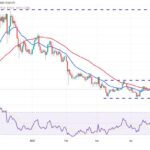In a move that many had anticipated, the U.S. Federal Reserve announced on Wednesday it would maintain its benchmark fed funds rate steady at a range of 4.25% to 4.50%. This decision marks the third consecutive meeting where the Fed has opted to pause any monetary easing, highlighting a growing uncertainty about the economic landscape. “Uncertainty about the economic outlook has increased further,” the Fed stated in an accompanying document, emphasizing the dual risks of higher unemployment and rising inflation.
In the wake of this announcement, Bitcoin (BTC) saw a slight dip, dropping below the $97,000 mark to trade at approximately $96,600 shortly after the decision was revealed. Just before the Fed’s announcement, Bitcoin had enjoyed a rally powered by positive U.S.-China trade talk developments.
The Fed’s decision comes amidst a complex backdrop of economic challenges, including the rollout of global tariffs under the Trump administration. Inflation levels have remained stubbornly above the anticipated 2% target, raising concerns about how these tariffs might impact consumer prices. Furthermore, there are emerging signs that the economy is slowing down.
Market analysts are keeping a close watch, with many forecasting three potential rate cuts later this year, with July emerging as a likely candidate for the first reduction. However, Fed officials have stressed the need for clarity regarding the tariffs’ impact before they consider adjusting interest rates.
“All eyes are now on Powell’s upcoming remarks at 2:30 pm ET (18:30 UTC), which could provide critical insights into the Fed’s future plans and strategies,”
as market participants eagerly await indications of the central bank’s trajectory in this uncertain economic climate.

Key Points on U.S. Federal Reserve’s Monetary Policy and Economic Landscape
The recent decisions made by the U.S. Federal Reserve can significantly affect various aspects of individuals’ financial lives, including interest rates, investment choices, and overall economic stability. Here are the main takeaways:
- Fed Holds Interest Rates Steady:
- The benchmark fed funds rate remains at 4.25%-4.50%, indicating a pause in monetary easing.
- This is the third consecutive meeting without a rate change, highlighting cautiousness from the Fed.
- Increased Economic Uncertainty:
- The Fed acknowledges heightened uncertainty about the economic outlook.
- Risks associated with higher unemployment and inflation are growing.
- Impact of Tariffs:
- The Trump administration’s global tariff rollout creates challenges that may affect consumer price inflation.
- Policymakers are closely monitoring how these tariffs influence the economy before deciding on further rate adjustments.
- Bitcoin’s Volatility:
- Bitcoin (BTC) traded just below $97,000 after experiencing fluctuations due to U.S.-China trade talks.
- The cryptocurrency market is sensitive to economic changes and regulatory announcements, which can impact investors’ portfolios.
- Anticipation of Rate Cuts:
- Market participants expect three rate cuts this year, with July being a possible starting point.
- Such cuts could lower borrowing costs, potentially benefiting consumers and businesses.
- Upcoming Remarks from Jerome Powell:
- All eyes are on the Fed Chair’s remarks scheduled for 2:30 pm ET, which could provide insights into future monetary policy.
- The content of this speech may influence market behavior and investor confidence.
The ongoing decisions by the Federal Reserve not only shape the macroeconomic landscape but directly impact individual financial decisions, savings, and investment strategies.
Federal Reserve’s Steady Rate Decision: Economic Implications and Market Reactions
The U.S. Federal Reserve’s recent decision to maintain its benchmark fed funds rate between 4.25% and 4.50% has sparked a buzz in financial circles, a move anticipated by many analysts in light of the economic turbulence exacerbated by ongoing global trade tensions. While this steady stance illustrates the Fed’s cautious approach, it also raises questions about its position amidst growing inflationary pressures and potential employment instability.
Competitive Advantages: One of the key advantages of the Fed’s decision is the stabilizing effect it may have on market expectations. By holding rates steady, the Fed signals that it is attentively considering the delicate balance between inflation and employment. This careful maneuvering is likely to reassure investors and market participants, as it indicates a commitment to not overreact to short-term economic fluctuations. Furthermore, financial markets often prefer predictability, and this consistent approach offers signals that can guide investment strategies, allowing investors to recalibrate their portfolios with more confidence.
Disadvantages: However, the Fed’s pause also reflects the challenges it faces amidst rising economic uncertainties. The persistent inflation above the target threshold, coupled with the unknown variables introduced by tariffs, presents a significant risk factor that could complicate future monetary policy decisions. Moreover, market sentiment surrounding the expected three rate cuts later this year introduces its own set of challenges; if the Fed waits too long to act on economic signals, it risks allowing inflation to spiral further, leading to a more significant need for aggressive cuts later on.
This landscape could benefit certain sectors, particularly those that thrive in a lower interest rate environment, such as real estate and consumer borrowing markets. Conversely, industries reliant on stable consumer prices, such as retail and consumer goods, may experience challenges as fluctuating costs can deter spending—especially if tariffs continue to influence consumer pricing.
In terms of market participants, traders and investors who can adapt swiftly to changes in monetary policy stance stand to gain the most. However, businesses that are unable to adjust their pricing strategies or hedge against inflation might find themselves in precarious positions as consumer purchasing behavior shifts. The coming remarks from Fed Chair Powell are anticipated to provide further insights, potentially shifting market dynamics significantly based on his outlook for the future.
















